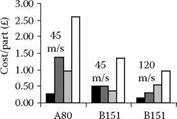Costs for grinding AISI 52100 were compared for the best conditions found for each grinding wheel and speed condition. The results are presented in Figure 19.31. An A60-SG abrasive designed for high removal rates gave the same quality level and reduced costs compared with conventional alumina abrasives. Vitrified CBN allowed an even higher removal rate at conventional speed further reducing costs and CBN at high speed allowed the highest removal rates and produced the lowest costs.
Costs per part were lower with high-speed CBN despite using a much more expensive machine for this speed. Redress life as indicated by the number of parts ground per dress was also increased using CBN and was further increased at high wheel speed.
Figure 19.32 compares costs/part when grinding Inconel 718 under the best conditions found with different grinding wheels. As with easy-to-grind material, CBN allowed lower costs at conventional wheel speed. However, this was at the same removal rate as used for the alumina wheel. Removal rate could not be increased due to the requirement to stay within tolerances over a reasonable redress life. One part/dress was achieved with alumina and 25 parts/dress with CBN. Using CBN at high wheel speed further improved redress life to 30 parts/dress. This improvement was achieved by limiting removal rate to 2 mm3/mm/s for all three conditions.
19.10.12 Effects of Redress Life
 |
With AISI 52100, redress life was high, so that abrasive cost, dressing cost, and machine cost became negligible compared to removal rate. With high redress life, costs depend primarily on removal rate and
dwell time. This was also found when grinding at high speed with CBN. Increasing wheel speed allowed removal rates to be increased and dwell time to be reduced while maintaining redress life and quality levels.
However, redress life was short for Inconel 718. In this case, removal rates had to be kept low to allow redress life to be increased. Increasing redress life was the only way to reduce costs. Increasing wheel speed was important to increase redress life.
Figure 19.31 and Figure 19.32 show that high-speed CBN grinding reduces total cost/part for both materials. This is largely due to increased redress life. With AISI 52100, a high redress life was maintained with a high removal rate and short dwell time. With Inconel 718, removal rate had to be kept low to increase redress life. However, high wheel speed also allowed spark-out time to be reduced while maintaining workpiece quality and increased redress life.
19.10.13 Economic Conclusions
• Vitrified CBN offers advantages at conventional speeds and at high speeds even with a much more expensive machine. This is largely due to longer redress life.
• Increased removal rates are only economic if achieved with long redress life and good quality levels. Long redress life is particularly important in cost reduction for difficult — to-grind materials.
• With high removal rates, long redress life, and short spark-out periods, machine and abrasive costs become negligible.
